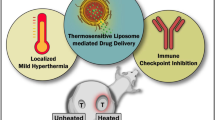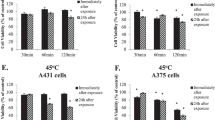Abstract
Resistance to apoptosis is a prominent feature of malignant melanoma. Hyperthermic therapy can be an effective adjuvant treatment for some tumors including melanoma. We developed a fusion protein based on the tissue inhibitor of matrix metalloproteinase-1 linked to a glycosylphosphatidylinositol anchor (TIMP-1-GPI). The TIMP-1-GPI-fusion protein shows unique properties. Exogenous administration of TIMP-1-GPI can result in transient morphological changes to treated cells including modulation of proliferation and decreased resistance to apoptosis. The effect of TIMP-1-GPI on the biology of melanoma in the context of a defined hyperthermic dose was evaluated in vitro. Clonogenic assays were used to measure cell survival. Gelatinase zymography determined secretion of MMP-2 and MMP-9. Monoclonal antibody against FAS/CD95 was applied to induce apoptosis. The expression of pro- and anti-apoptotic proteins and the secretion of immunoregulatory cytokines were then evaluated using Western blot and ELISA. TIMP-1-GPI combined with a sub-lethal hyperthermic treatment (41.8°C for 2 h) suppressed tumor cell growth capacity as measured by clonogenic assay. The co-treatment also significantly suppressed tumor cell proliferation, enhanced FAS receptor surface expression increased tumor cell susceptibility to FAS-mediated killing. The increased sensitivity to FAS-induced apoptosis was linked to alterations in the apoptotic mediators Bcl-2, Bax, Bcl-XL and Apaf-1. The agent works in concert with sub-lethal hyperthermic treatment to render melanoma cells sensitive to FAS killing. The targeted delivery of TIMP-1-GPI to tumor environments in the context of regional hyperthermic therapy could be optimized through the use of thermosensitive liposomes.






Similar content being viewed by others
References
Egeblad M, Werb Z (2002) New functions for the matrix metalloproteinases in cancer progression. Nat Rev Cancer 2(3):161–174
Itoh Y, Nagase H (2002) Matrix metalloproteinases in cancer. Essays Biochem 38:21–36
Bode W, Maskos K (2003) Structural basis of the matrix metalloproteinases and their physiological inhibitors, the tissue inhibitors of metalloproteinases. Biol Chem 384(6):863–872
Nagase H, Woessner JF Jr (1999) Matrix metalloproteinases. J Biol Chem 274(31):21491–21494
Brew K, Dinakarpandian D, Nagase H (2000) Tissue inhibitors of metalloproteinases: evolution, structure and function. Biochim Biophys Acta 1477(1–2):267–283
Klier CM, Nelson EL, Cohen CD, Horuk R, Schlondorff D, Nelson PJ (2001) Chemokine-induced secretion of gelatinase B in primary human monocytes. Biol Chem 382(9):1405–1410
Sorensen NM, Bystrom P, Christensen IJ, Berglund A, Nielsen HJ, Brunner N, Glimelius B (2007) TIMP-1 is significantly associated with objective response and survival in metastatic colorectal cancer patients receiving combination of irinotecan, 5-fluorouracil, and folinic acid. Clin Cancer Res 13(14):4117–4122
Brand K (2002) Cancer gene therapy with tissue inhibitors of metalloproteinases (TIMPs). Curr Gene Ther 2(2):255–271
Chirco R, Liu XW, Jung KK, Kim HR (2006) Novel functions of TIMPs in cell signaling. Cancer Metastasis Rev 25(1):99–113
Medof ME, Nagarajan S, Tykocinski ML (1996) Cell-surface engineering with GPI-anchored proteins. FASEB J 10(5):574–586
Djafarzadeh R, Mojaat A, Vicente AB, von Luttichau I, Nelson PJ (2004) Exogenously added GPI-anchored tissue inhibitor of matrix metalloproteinase-1 (TIMP-1) displays enhanced and novel biological activities. Biol Chem 385(7):655–663
Djafarzadeh R, Noessner E, Engelmann H, Schendel DJ, Notohamiprodjo M, von Luettichau I, Nelson PJ (2006) GPI-anchored TIMP-1 treatment renders renal cell carcinoma sensitive to FAS-meditated killing. Oncogene 25(10):1496–1508
Brown O, Cowen RL, Preston CM, Castro MG, Lowenstein PR (2000) Subcellular post-transcriptional targeting: delivery of an intracellular protein to the extracellular leaflet of the plasma membrane using a glycosyl-phosphatidylinositol (GPI) membrane anchor in neurons and polarised epithelial cells. Gene Ther 7(22):1947–1953
Garbe C, Eigentler TK (2007) Diagnosis, treatment of cutaneous melanoma: state of the art 2006. Melanoma Res 17(2):117–127
La Porta CA (2007) Drug resistance in melanoma: new perspectives. Curr Med Chem 14(4):387–391
Facchetti F, Previdi S, Ballarini M, Minucci S, Perego P, La Porta CA (2004) Modulation of pro- and anti-apoptotic factors in human melanoma cells exposed to histone deacetylase inhibitors. Apoptosis 9(5):573–582
Soengas MS, Lowe SW (2003) Apoptosis and melanoma chemoresistance. Oncogene 22(20):3138–3151
Overgaard J, Gonzalez Gonzalez D, Hulshof MC, Arcangeli G, Dahl O, Mella O, Bentzen SM (1995) Randomised trial of hyperthermia as adjuvant to radiotherapy for recurrent or metastatic malignant melanoma. European Society for Hyperthermic Oncology. Lancet 345(8949):540–543
van der Zee J, Gonzalez Gonzalez D, van Rhoon GC, van Dijk JD, van Putten WL, Hart AA (2000) Comparison of radiotherapy alone with radiotherapy plus hyperthermia in locally advanced pelvic tumours: a prospective, randomised, multicentre trial. Dutch Deep Hyperthermia Group. Lancet 355(9210):1119–1125
Jones EL, Oleson JR, Prosnitz LR, Samulski TV, Vujaskovic Z, Yu D, Sanders LL, Dewhirst MW (2005) Randomized trial of hyperthermia and radiation for superficial tumors. J Clin Oncol 23(13):3079–3085
Fraker DL (2004) Management of in-transit melanoma of the extremity with isolated limb perfusion. Curr Treat Options Oncol 5(3):173–184
Sanki A, Kam PC, Thompson JF (2007) Long-term results of hyperthermic, isolated limb perfusion for melanoma: a reflection of tumor biology. Ann Surg 245(4):591–596
Kampinga HH (2006) Cell biological effects of hyperthermia alone or combined with radiation or drugs: a short introduction to newcomers in the field. Int J Hyperthermia 22(3):191–196
Milani V, Frankenberger B, Heinz O, Brandl A, Ruhland S, Issels RD, Noessner E (2005) Melanoma-associated antigen tyrosinase but not Melan-A/MART-1 expression and presentation dissociate during the heat shock response. Int Immunol 17(3):257–268
Rivoltini L, Barracchini KC, Viggiano V, Kawakami Y, Smith A, Mixon A, Restifo NP, Topalian SL, Simonis TB, Rosenberg SA et al (1995) Quantitative correlation between HLA class I allele expression and recognition of melanoma cells by antigen-specific cytotoxic T lymphocytes. Cancer Res 55(14):3149–3157
Kirby AC, Hill V, Olsen I, Porter SR (1995) LFA-3 delta D2: a novel in vivo isoform of lymphocyte function-associated antigen 3. Biochem Biophys Res Commun 214(1):200–205
Mack M, Riethmuller G, Kufer P (1995) A small bispecific antibody construct expressed as a functional single-chain molecule with high tumor cell cytotoxicity. Proc Natl Acad Sci USA 92(15):7021–7025
Overgaard J, Suit HD (1979) Time-temperature relationship the hyperthermic treatment of malignant and normal tissue in vivo. Cancer Res 39(8):3248–3253
Issels RD, Nagele A (1990) Influence of thiols on thermosensitivity of mammalian cells in vitro. Methods Enzymol 186:696–708
Schwabe RF, Hess S, Johnson JP, Engelmann H (1997) Modulation of soluble CD40 ligand bioactivity with anti-CD40 antibodies. Hybridoma 16(3):217–226
Noessner E, Gastpar R, Milani V, Brandl A, Hutzler PJ, Kuppner MC, Roos M, Kremmer E, Asea A, Calderwood SK, Issels RD (2002) Tumor-derived heat shock protein 70 peptide complexes are cross-presented by human dendritic cells. J Immunol 169(10):5424–5432
Dewhirst MW, Viglianti BL, Lora-Michiels M, Hanson M, Hoopes PJ (2003) Basic principles of thermal dosimetry and thermal thresholds for tissue damage from hyperthermia. Int J Hyperthermia 19(3):267–294
Ko HM, Kang JH, Jung B, Kim HA, Park SJ, Kim KJ, Kang YR, Lee HK, Im SY (2007) Critical role for matrix metalloproteinase-9 in platelet-activating factor-induced experimental tumor metastasis. Int J Cancer 120(6):1277–1283
Qu XJ, Yuan YX, Tian ZG, Xu WF, Chen MH, Cui SX, Guo Q, Gai R, Makuuchi M, Nakata M, Tang W (2006) Using caffeoyl pyrrolidine derivative LY52, a potential inhibitor of matrix metalloproteinase-2, to suppress tumor invasion and metastasis. Int J Mol Med 18(4):609–614
Igney FH, Krammer PH (2002) Death and anti-death: tumour resistance to apoptosis. Nat Rev Cancer 2(4):277–288
Bao Q, Shi Y (2007) Apoptosome: a platform for the activation of initiator caspases. Cell Death Differ 14(1):56–65
Rothhammer T, Poser I, Soncin F, Bataille F, Moser M, Bosserhoff AK (2005) Bone morphogenic proteins are overexpressed in malignant melanoma and promote cell invasion and migration. Cancer Res 65(2):448–456
Karsdal MA, Larsen L, Engsig MT, Lou H, Ferreras M, Lochter A, Delaisse JM, Foged NT (2002) Matrix metalloproteinase-dependent activation of latent transforming growth factor-beta controls the conversion of osteoblasts into osteocytes by blocking osteoblast apoptosis. J Biol Chem 277(46):44061–44067
Illman SA, Lehti K, Keski-Oja J, Lohi J (2006) Epilysin (MMP-28) induces TGF-beta mediated epithelial to mesenchymal transition in lung carcinoma cells. J Cell Sci 119(Pt 18):3856–3865
Polak ME, Borthwick NJ, Gabriel FG, Johnson P, Higgins B, Hurren J, McCormick D, Jager MJ, Cree IA (2007) Mechanisms of local immunosuppression in cutaneous melanoma. Br J Cancer 96(12):1879–1887
Barnhart BC, Lee JC, Alappat EC, Peter ME (2003) The death effector domain protein family. Oncogene 22(53):8634–8644
Jaattela M (2004) Multiple cell death pathways as regulators of tumour initiation and progression. Oncogene 23(16):2746–2756
Shi Y (2006) Mechanical aspects of apoptosome assembly. Curr Opin Cell Biol 18(6):677–684
Gorelik L, Flavell RA (2002) Transforming growth factor-beta in T-cell biology. Nat Rev Immunol 2(1):46–53
Gold LI (1999) The role for transforming growth factor-beta (TGF-beta) in human cancer. Crit Rev Oncog 10(4):303–360
Peng Y, Gorelik L, Laouar Y, Li MO, Flavell RA (2006) TGFbeta-mediated immunoregulation. Ernst Schering Res Found Workshop, (56):155–60
Conti P, Kempuraj D, Kandere K, Di Gioacchino M, Barbacane RC, Castellani ML, Felaco M, Boucher W, Letourneau R, Theoharides TC (2003) IL-10, an inflammatory/inhibitory cytokine, but not always. Immunol Lett 86(2):123–129
Lauw FN, Pajkrt D, Hack CE, Kurimoto M, van Deventer SJ, van der Poll T (2000) Proinflammatory effects of IL-10 during human endotoxemia. J Immunol 165(5):2783–2789
Santin AD, Hermonat PL, Ravaggi A, Bellone S, Pecorelli S, Roman JJ, Parham GP, Cannon MJ (2000) Interleukin-10 increases Th1 cytokine production and cytotoxic potential in human papillomavirus-specific CD8(+) cytotoxic T lymphocytes. J Virol 74(10):4729–4737
Sharma D, Chelvi TP, Kaur J, Ralhan R (1998) Thermosensitive liposomal taxol formulation: heat-mediated targeted drug delivery in murine melanoma. Melanoma Res 8(3):240–244
Han HD, Choi MS, Hwang T, Song CK, Seong H, Kim TW, Choi HS, Shin BC (2006) Hyperthermia-induced antitumor activity of thermosensitive polymer modified temperature-sensitive liposomes. J Pharm Sci 95(9):1909–1917
Minko T, Pakunlu RI, Wang Y, Khandare JJ, Saad M (2006) New generation of liposomal drugs for cancer. Anticancer Agents Med Chem 6(6):537–552
Noorda EM, Vrouenraets BC, Nieweg OE, Klaase JM, van der Zee J, Kroon BB (2003) Long-term results of a double perfusion schedule using high dose hyperthermia and melphalan sequentially in extensive melanoma of the lower limb. Melanoma Res 13(4):395–399
Robins HI, D’Oleire F, Grosen E, Spriggs D (1997) Rationale and clinical status of 41.8 degrees C systemic hyperthermia tumor necrosis factor, and melphalan for neoplastic disease. Anticancer Res 17(4B):2891–2894
Pagani E, Falcinelli S, Pepponi R, Turriziani M, Caporaso P, Caporali S, Bonmassar E, D’Atri S (2007) Combined effect of temozolomide and hyperthermia on human melanoma cell growth and O6-methylguanine-DNA methyltransferase activity. Int J Oncol 30(2):443–451
Acknowledgments
The work described here was supported by DFG grant NE 648/2-3 to PJN, SFB 455 to EN, SFB-TR36 to PJN and EN, and by a grant from the Sanitätsrat Emil Hübner Stiftung to IvL.
Author information
Authors and Affiliations
Corresponding author
Additional information
Elfriede Noessner, Peter J. Nelson are equal contributors.
Rights and permissions
About this article
Cite this article
Djafarzadeh, R., Milani, V., Rieth, N. et al. TIMP-1-GPI in combination with hyperthermic treatment of melanoma increases sensitivity to FAS-mediated apoptosis. Cancer Immunol Immunother 58, 361–371 (2009). https://doi.org/10.1007/s00262-008-0559-5
Received:
Accepted:
Published:
Issue Date:
DOI: https://doi.org/10.1007/s00262-008-0559-5




